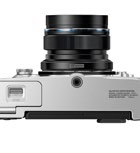Olympus Pen-F.


Olympus Pen-F.

Olympus’ newest mirrorless camera is named after the first Pen F,which was released in 1963. The two Pen-Fs even look similar; the new Pen-F has a stunningly distinctive retro look, and is easily one of the most attractive digital cameras ever made.
The Pen-F is Olympus’ first Pen with an electronic viewfinder built-in, a new 20MP sensor without an optical low-pass filter, as well as Olympus’ excellent 5-axis optical image stabilization, a tilting LCD, built-in Wi-Fi, and a compact flash attachment with tilting head.
The camera feels good in the hands. It’s solid, not light at approx. 427g (with battery and memory card), but not heavy either. The protruding thumb-rest gives you a good hold, and if you don’t mind increasing the camera’s size, there’s an optional front-grip you can buy and attach.
Everything feels like it’s in the right place, with a physical Mode dial, exposure compensation dial, and twin control dials that come with the 2x2 feature introduced on the E-M1. The round Power button originally looked more retro than useful, but it’s surprisingly easy to turn, thanks to its knurled surface.
Another feature that first struck me as more ornamental than useful is the new Creative Dial on the front of the body. The Creative Dial has five settings, Off, Color, Mono, Art and Color Control. In other words, it gives you quick access to color, black and white or effect presets.
I was quite surprised at quite often Iused it. The Color, Mono and Color Control modes are brand new, and they let you either tweak color settings and save them as presets, or use Olympus’ own presets, each of which has a different look, all of which are modeled after the look of classic films.
The tilting LCD provided a good way to capture unusual angles, and Ifound the electronic viewfinder bright and responsive. Blackout time is impressively short, and the Pen-F has a silent shooting mode which is very quiet.
In good light, the extra resolution on the Pen-F, together with the lack of an optical low-pass filter, results in images that shine with good detail, especially when paired with any of the good lenses in the MFT stable. The higher megapixel count is also welcome when Iswitch to a DSLR-like 3:2 aspect ratio, which gives me images that are still approx. 17.9MP. On previous 16MP MFT cameras, switching aspect ratios would cut resolution down to 14MP.
On the other hand, the new sensor doesn’t measure up as well to the latest generation of APS-C sensors when it comes to low light performance. At ISO 1,600 and 3,200, the Pen-F is good, with low visible noise, but not great, with smudging of fine detail.
The Pen-F’s 5-axis optical image stabilization (OIS) is exemplary, and helped me nail more sharp images at low shutter speeds than I’d ordinarily expect. I’ve even gotten some steady images with a shutter speed of a full second when handholding the camera — which would be impossible with a heavy full-frame DSLR.
The OIS also works while shooting video, which helps to make the shot steadier and less shaky. While it works well, it also introduces some odd jerkiness at times, when there’s a sudden pan or camera movement.
The Pen-F checks allthe right boxes to become a portable camera companion. It’s clear that Olympus’ has done some of their best work on the Pen-F, and it’s a new classic for our age that would make its namesake proud.
But it is expensive, especially when you consider that you can either get the top-of-the-line OM-D E-M1 for not much more, or the E-M5 Mark IIfor quite a bit less. However, if you’re willing to fork out the extra coin, the Pen-F has that right combination of specs and heart to make it not just a piece of gear you use, but to become a camera you’d grow to love using.


CONCLUSION
An excellent, if expensive, camera. It’s just fun to shoot with.
























